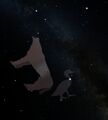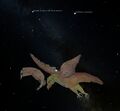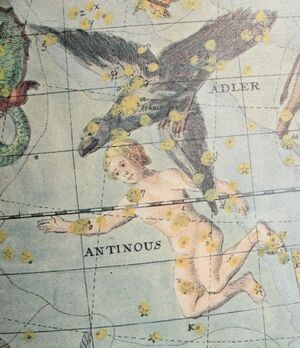Antinous: Difference between revisions
| Line 7: | Line 7: | ||
In the sky, Antinous was now part of the constellation of the Eagle, and in the Almagest the stars are listed as a separate group in this constellation. |
In the sky, Antinous was now part of the constellation of the Eagle, and in the Almagest the stars are listed as a separate group in this constellation. |
||
[[File:Aqldel ptolbabtxt.png|thumb|Babylonian constellation Aquila with Corpse (smh 2017)]] |
|||
Interestingly, the eagle is one of the "Greek" constellations that are taken directly from Babylonian uranography. The Babylonians also had a bird of prey, an eagle (or a vulture), in exactly the same place in the sky. Next to the Babylonian constellation Eagle is the Babylonian constellation The Corpse. Since the Almagest contains many Babylonian reminiscences (e.g. Babylonian eclipse observations are quoted), it could be that Ptolemy's new creation refers to the older Babylonian constellation and merely changes its name. |
Interestingly, the eagle is one of the "Greek" constellations that are taken directly from Babylonian uranography. The Babylonians also had a bird of prey, an eagle (or a vulture), in exactly the same place in the sky. Next to the Babylonian constellation Eagle is the Babylonian constellation The Corpse. Since the Almagest contains many Babylonian reminiscences (e.g. Babylonian eclipse observations are quoted), it could be that Ptolemy's new creation refers to the older Babylonian constellation and merely changes its name. |
||
The Babylonian astronomical compendium MUL.APIN is of unknown date but certainly compiled before 1000 BCE. |
|||
* definition in MUL.APIN list I.1 (line I ii 12): ''original:'' DIŠ MUL <sup>d</sup>Za-ba<sub>4</sub>-ba<sub>4</sub> <sup>mul</sup>Ti<sub>8</sub><sup>mušen</sup> u <sup>mul</sup>AD<sub>6</sub> ''Akkadian:'' Kakkab Zababa Erû u Pagru ''English:'' The asterism of Zababa, the Eagle, and the Dead Man. Obviously, the Dead Man (or Corpse) forms part of a constellation together with the Eagle and with the god Zababa (a warlike god and city god of Kish, identified with the god of war Ninurta). |
|||
In the Hathor temple in Dendera (Egypt), there are two zodiakoi: a rectangular zodiac in the pronaos which is in drawn in the typical Egyptian style in an extraordinarily high ceiling, in two lanes across the whole depth of the room, and a small circular zodiac in the ceiling of the pronaos of a small Osiris chapel at the roof of the Hathor temple. This ceiling is low, touchable by human hands, as the whole room is hardly high enough for average people. Therefore, this star chart is not as divine as the one in the entrance hall of the temple. Hoffmann (2022) suggested that the whole map is a Babylonian star chart in Greco-Egyptian painting style. |
|||
* At the place of the Babylonian Eagle and the Corpse, there is a duck and an animal cadaver. |
|||
<gallery> |
|||
File:Eagle+Corpse Dendera-zodiac2022.jpg|In the circular zodiac in Dendera (Roman time Egypt), at the place of the Ealge, a Duck is depicted. Next to it, we find the corpse of an animal. It may be placed on the stars of Delphinus or south of the duck but somewhere in this area. This is a visualiation produced for Stellarium (Hoffmann 2022). |
|||
File:Eagle+Corpse MULAPIN-jessica2022.jpg|Babylonian constellations The Eagle and The Corpse, drawn by Jessica Gullberg for the planetarium software Stellarium, cf. Gullberg, Hoffmann, Gullberg (2022) |
|||
File:Aqldel ptolbabtxt.png|possible Babylonian model of Eagle and Corpse next to the constellation of The Pig in IAU-Delphinus, suggested by S.M. Hoffmann (2018). The man and the bird are drawn as described in Ptolemy's Almagest. |
|||
</gallery> |
|||
==== Our modern dedication ==== |
==== Our modern dedication ==== |
||
Revision as of 06:00, 5 March 2024
A "sub"-constellation (or asterism) Antinous was created by Ptolemy of Alexandria and published in the Almagest star catalogue 137 CE.
Name
Origin of the name/ story behind it
Antinous is the name of the favourit of Emperor Hadrian of Rome. When Hadrian was in Egypt, Antinous drowned in the Nile. It was unclear from the outset whether this was an accident, suicide or murder. Of course, it can no longer be clarified today. The fact is that he fell into the water, could not swim and drowned. The grief-stricken emperor then declared a state of mourning in the Roman Empire and a cult of veneration began: Hadrian had a temple built for Antinous in the city of Rome, Antinous games were held in Athens and the astronomer Ptolemy of Alexandria placed the name of the deceased among the stars by inventing a new constellation.
In the sky, Antinous was now part of the constellation of the Eagle, and in the Almagest the stars are listed as a separate group in this constellation.
Interestingly, the eagle is one of the "Greek" constellations that are taken directly from Babylonian uranography. The Babylonians also had a bird of prey, an eagle (or a vulture), in exactly the same place in the sky. Next to the Babylonian constellation Eagle is the Babylonian constellation The Corpse. Since the Almagest contains many Babylonian reminiscences (e.g. Babylonian eclipse observations are quoted), it could be that Ptolemy's new creation refers to the older Babylonian constellation and merely changes its name.
The Babylonian astronomical compendium MUL.APIN is of unknown date but certainly compiled before 1000 BCE.
- definition in MUL.APIN list I.1 (line I ii 12): original: DIŠ MUL dZa-ba4-ba4 mulTi8mušen u mulAD6 Akkadian: Kakkab Zababa Erû u Pagru English: The asterism of Zababa, the Eagle, and the Dead Man. Obviously, the Dead Man (or Corpse) forms part of a constellation together with the Eagle and with the god Zababa (a warlike god and city god of Kish, identified with the god of war Ninurta).
In the Hathor temple in Dendera (Egypt), there are two zodiakoi: a rectangular zodiac in the pronaos which is in drawn in the typical Egyptian style in an extraordinarily high ceiling, in two lanes across the whole depth of the room, and a small circular zodiac in the ceiling of the pronaos of a small Osiris chapel at the roof of the Hathor temple. This ceiling is low, touchable by human hands, as the whole room is hardly high enough for average people. Therefore, this star chart is not as divine as the one in the entrance hall of the temple. Hoffmann (2022) suggested that the whole map is a Babylonian star chart in Greco-Egyptian painting style.
- At the place of the Babylonian Eagle and the Corpse, there is a duck and an animal cadaver.
In the circular zodiac in Dendera (Roman time Egypt), at the place of the Ealge, a Duck is depicted. Next to it, we find the corpse of an animal. It may be placed on the stars of Delphinus or south of the duck but somewhere in this area. This is a visualiation produced for Stellarium (Hoffmann 2022).
Our modern dedication
Ian Ridpath in his comprehensive book on Star Tales points out that the relationship of Antinous and Hadrian is not quite clear. He was definitely more than just a friend or consultant for the emperor. It may have been pederasty or a usual homosexual relation. Therefore, aiming at inclusion, astronomers of the 20th and 21st century prefer to use this asterism as a symbol of homosexuality in general (and not to link it with pederasty).
Reference(s)
Historical source
Almagest ...
Early Depiction(s)
- Bode 1781
- Fortin (?)
- Flamsteed (?)
- ...
Weblinks
References
Ian Ridpath: Star Tales
Susanne M Hoffmann ... blablabla
Suggested for ISC by
Ian Ridpath and Susanne M Hoffmann (independently) for theta Aquilae (head of Ptolemy's figure)









